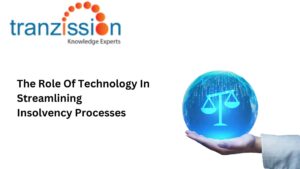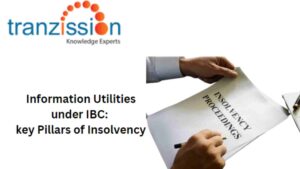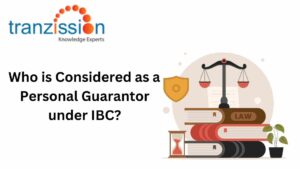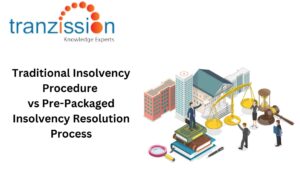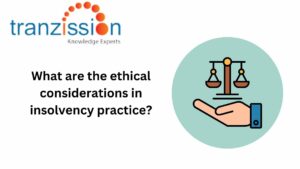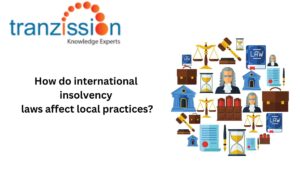
Information Utilities under IBC: key Pillars of Insolvency
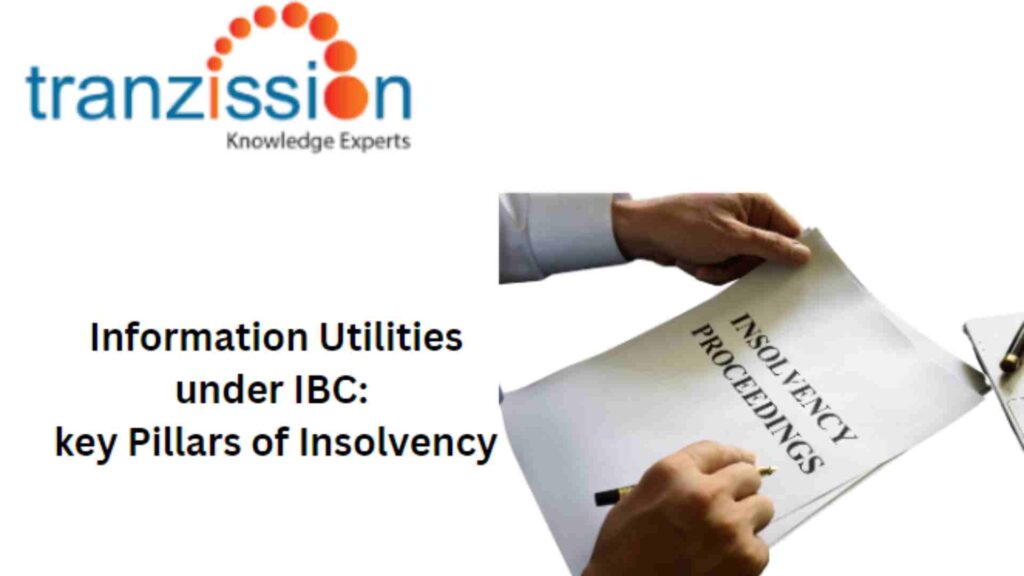
Table of Contents
The success of the insolvency proceedings depends on the information submitted by the corporate debtor. By not providing updated and accurate information, the insolvency process may impede and comprise the valuation of the corporate debtor’s assets. Traditionally this has been done through a paper process, but due to the increase in technology, Information Utilities under IBC have the main role of collecting and maintaining financial information through an electronic database. An information utility is important for overlooking the financial information throughout this process. Hence, it becomes important to understand their role during insolvency, bankruptcy, and liquidation proceedings.
What is Information Utilities under IBC?
As per section 3(21) of the Insolvency and Bankruptcy Code, 2016 (hereon forward known as “IBC”), an information utility (IU) is a person who is registered with the Insolvency and Bankruptcy Board of India (IBBI) under section 210, according to the eligibility criteria specified under the Insolvency and Bankruptcy Board of India (Information Utilities under IBC) Regulations, 2017 (hereon forward known as “IU Regulations”). An IU has to maintain an electronic database of information and authentic information to eliminate any delays and disputes regarding claims and/ or defaults.
The reason behind the creation of Information Utilities
There are many issues with traditional paper-based processes, such as the need to ensure the credibility of documents and reduced productivity. The advancement of technology has reduced the cost and time of these documents by making it mainly electronic and simplifying the otherwise complex resolution process. Therefore, by introducing IUs, the information delays are eliminated and conflicts in resolving the financial distress of the corporate debtor by decreasing their costs and delays.
Regulation of Information Utilities under IBC
IUs are governed by the IBC and the IU Regulations:
1) The definition of information utilities is given under the IBC.
2) To be registered an IU, as per Regulation 3 of the IUs Regulations, a public company must have its sole object to provide core services and other services under these Regulations, a minimum net worth of Rs. 50 crores, must be ‘fit and proper under the Regulations.
3) The IBBI may lay down the Technical Standards through guidelines for performing core services and other services under the Regulations. These Technical standards apply to the submission of information, authentication of information, data integrity, etc. These measures ensure that the information with the IUs is admissible as evidence. After recording the status of information of default, the IU communicates the status of authentication to the registered users, who are the creditors of the debtor who defaulted, and the parties and sureties to the debt in respect of which the information of default has been received.
4) Regulation 26(1) of the IUs Regulations enables an IU to import from registries, such as the Reserve Bank of India and the Securities and Exchange Board of India, that may be notified occasionally.
Obligations of Information Utilities under IBC
The obligations of an IU is given under section 215 of IBC:
1) create and store financial information in a universally accessible format
2) accept electronic submissions of financial information from persons who have to submit financial information as per section 215 in Form C of the Schedule of the IU Regulations.
3) accept the electronic submissions of financial information from persons who intend to submit such information
4) meet the minimum service quality standards as specified under the IUs Regulations.
5) get the information received from various persons authenticated by all concerned parties before storing such information
6) provide access to the financial statement stored by it to any person who intends to access such information
7) publish such statistical information as per the specifications under Regulation 36A of the IU Regulations.
8) have interoperability with other Information Utilities under IBC .
Read more : Difference between a liquidator and an insolvency professional
Duties of Information Utilities under IBC
The duties of IUs are listed under Chapter VI of the IUs Regulations:
1) General duties under Regulation 28: The IU should provide services with due and reasonable care, skill, and diligence, and it should hold the information as a custodian.
2) The IU should provide its services without discrimination. As per Regulation 29, this includes their place of residence or business or personality types, natural or artificial.
3) Other duties are included in Regulation 30(1), including guaranteeing protection of the rights of users, establishing adequate procedures and facilities to ensure that its records are protected against loss or destruction, protecting its data processing systems against unauthorised access, alteration, destruction, disclosure or user.
However, there are certain restrictions to their duties. It is important the Information Utilities under IBC should not, under Regulation 30(2), outsource the provision of core services to a third-party service provider, use the information stored for any person other than those listed under these Regulations without the prior approval of the IBBI, and seek data or details of users except as required for the provision of the services under the IU Regulations.
Registered Users
Under Regulation 2(2), a ‘user’ is anyone who avails of the services of an Information Utilities under IBC. The IBBI may lay down the Technical Standards for the registration of users with the IU. The IUs Regulations do mention the registration of users under Regulation 18. A person shall register himself with an IU for submitting information or accessing information stored with any of the IUs. Once this user has registered with an IU, they cannot register with another IU.
A user who has submitted information in Form C of the Schedule to an IU shall submit the information updated on the last day of every month in the first week of the following month. An IU shall permit the user to view the date the information was last updated, the status of authentication, and the status of verification while providing access to the information.
Under Regulation 25(1) of the IUs Regulations, an IU should provide every registered user an annual statement of all information pertaining to the user, free of charge. An IU should also arrange for indemnifying the users for losses that may be caused due to any wrongful act, negligence, or default of the IU, it employees, or other person whose services are used for the provision of services under the IUs Regulations.
Authentication of Default
An IU should expeditiously undertake the process of authentication and verification of information of default as soon as it is received as per Regulation 21(1) of the IU Regulations. As per Regulation 21(2), the IU should:
1) The IU should deliver the default information to the corporate debtor, seeking confirmation within 7 days.
2) The IU should remind the IU at least 3 times for confirmation. If the debtor does not respond, 7 days will be allowed to each time for their response.
3) After that, the information should be deliver the information or the reminder to the debtor by hand, post, or electronic means at the postal or e-mail address of the debtor registered with MCA-21 and the Central Registry of Securitisation Asset Reconstruction and Security Interest of India (CERSAI) registry as repositories or any other statutory repository approved by the IBBI, failing which submitted in Form C of the Schedule by a financial creditor which is a bank included in the second schedule of the Reserve Bank of India Act, 1934 or by any other creditor.
4) The IU should record the status of authentication of information of default.
5) The IU should communicate the status of the authentication in physical or electronic form by issuing a record of default in Form D of the Schedule to the registered users who are the creditors who have defaulted in payment of a debtor or are parties or sureties to the debt.
The IU should record the status of information of the financial creditors as so:
| S.No. | Response of debtor | Status of Authentication | Colour of Status | |
| (1) | (2) | (3) | (4) | |
| 1 | Debtor confirms the information of default | Authenticated | Green | |
| 2 | Debtor disputes the information of default | Disputed | Red | |
| 3 | Debtor does not respond after 3 reminders | Deemed to be authenticated | Yellow | |
If the financial creditors are banks as per the second schedule of the Reserve Bank of India Act, 1934, the status of authentication will be recorded as under:
| S.No. | Response of debtor | Status of Authentication | Colour of Status |
| (1) | (2) | (3) | (4) |
| 1 | a) Debtor confirms the information of default
b) Debtor does not respond after 3 reminders |
Authenticated | Green |
| 2 | Debtor disputes the information of default | Disputed | Red |
Use of Financial Information
The IUs store financial information and should help to establish defaults before the NCLT, verification of claims by the resolution professional, constitution of the committee of creditors, etc., to expeditiously and facilitate completion of the process under the IBC as per the timeline. The use of this information is:
| In the Corporate Insolvency Resolution Process | In Liquidation Process
|
In Individual Insolvency Resolution Process |
| · Under section 7(4) of IBC, the NCLT shall, within 14 days of receiving the application for initiation of CIRP, ascertain the existence of a default from the records of the IU as per the evidence by the financial creditor.
· As section 9(3)(d), the operational creditor should attach a copy of any record with IU confirming that there is not payment of an unpaid operational debtor by the corporate debtor. · The NCLT, within 14 days from receiving an application under section 9 may admit it if no notice of dispute has been received the operational creditor or no record of dispute in IU. |
· The liquidation estate
· The liquidator has the power to access any information system for the purpose of admission and proof of claims and identification of the liquidation estate assets relating to the corporate debtor · Regulations 17-20 of the Insolvency and Bankruptcy Board of India (Liquidation Process) Regulations, 2016 permit the creditor or stakeholder to prove the existence of debt based on the records available with an IU |
· The creditor may prove its claim based on the records available in an IU, which substantiates the existence of a claim. |
Admissibility of Electronic Records of Information Utility as evidence
Categories of Information
The Report of the Bankruptcy Law Reforms Committee defined the categories of information to ensure that the resolution process is efficient:
1) Reliable and readily accessible records of liabilities of a solvent entity
2) Clear evidence of the instance of default
3) Records of assets that are pledged as collateral against secured credit contracts
4) Reliable and readily accessible records that comprise the balance sheet and cash flow statements
Information Submission: Mandatory or Optional
It is important that the initiation of the CIRP, may use the information available to IUs to prove the existence of the debt and default. As per section 215(1), any person who intends to submit financial information to the IU or access the information from the IU should pay the fee and information in the form and manner under the IU Regulations. Under section 215(2), the financial creditor has to submit the financial information. As per section 215(3), the operational creditor has the option to submit the financial information to the IUs.
Under section 3(13) of IBC, financial information includes:
a) Records of the debt of the person
b) Records of liabilities when the person is solvent
c) Records of assets of person over which security interest has been created
d) Records of instances of default by the person against any debt
e) Records of the balance sheet and cash flow statements of the person
f) Other information that may be specified in regulations.
Disclosure of Information
It is important that the IUs be confidential as sensitive information may be stored and should not be infringed upon. Certain scenarios in which the information must be disclosed:
1) Disclosure of information of the debtor should take place only with their permission
2) The financial creditor should be informed if the debtor has defaulted on a debt.
3) Once an application for initiating the corporate insolvency resolution process (CIRP) before the Adjudicating Authority, the National Company Law Tribunal (NCLT), the NCLT should have full access to the information about the corporate debtor from the IU.
4) At the commencement of the CIRP, information about the corporate debtor will be available to the public.
Ownership and Immutability of Information Utility Information
As per Regulation 28(2) of the IUs Regulations, the IU holds the information as a custodian and is not the owner of the information. As soon as the information is stored in with an IU should not, in any manner, be modified or deleted. As a custodian of the information, it is necessary that the IU should preserve the confidentiality of the information, so that the information may be accepted as evidence in a court of law. If the record is found to be incorrect, it should be marked as erroneous, stating the reasons.
Standards to be complied by Information Utility
The IBBI may lay down the Technical Standards for the Application Programming Interface as per under Regulation 13(2)(a). An IU shall abide by the common Application Programming Interface (API) standard, through which all IUs will interact with stakeholders to perform their core services. This system should be published by the regulator, and IUs should be mandated to implement it. This ensures that the IUs and client systems will speak the same ‘language’.
Services of Information Utilities under IBC
The role of IUs in the corporate insolvency proceedings depends on three factors:
1)The existence of information on debts and defaults in the IU
2)The validity of information in the IU as evidence in the court
3)The use of this information in the insolvency procedure.
The stages of the process in which the information in an IU is important is:
1)The default will be recorded at an IU and will be used as evidence by the NCLT to commence the CIRP.
2)The information for the IU will be used to determine all the creditors to the debtor to form the Committee of Creditors.
Core Services of Information Utility
As per section 3(9) of IBC, IUs have to provide core services regarding Information Utilities under IBC, which includes:
a) Acceptance of electronic submission of financial information
b) Safe and accurate recording of financial information
c) Authentication and verification of financial information
d) Providing access to information stored with them to specified persons
Processes followed in Information Utility
1) Mode of information submission: Under Regulation 20(1), the IU shall accept information submitted by a user in Form C of the Schedule. The information must be submitted electronically
2) Information authentication: Under section 214(2) of IBC, the IU has a duty to authenticate the information with other concerned parties. As per the IBC ‘concerned parties’, would be the debtor or creditor when the information is submitted to substantiate the existence of a debt contract, and when there is evidence of default, the debtor may not want to authenticate that it has defaulted, the concerned party could be defined as the creditor and the host bank.
3)Acknowledgement of information: After authentication, the IU shall provide an acknowledgement to the submitter and authenticator. This has several functions, such as acknowledging services as evidence that the statutory obligation to submit information to the IU protects against data loss by IUs.
4) Updating the information: If there are any changes to the financial information, such as the repayment of a loan, the user must update the IU.
5) Correcting erroneous information: Under Regulation 27(2) of the IUs Regulations read with the provisions of IBC, it is required that the user who intends to rectify errors to apply to the IU and state the reasons for such a request.
6)Storage of information: IUs has the duty to store the financial information. As per the Working Group on Information Utilities under IBC, it was recommended that IUs should have high-quality data storage systems with backup plans to ensure that the information is not lost or corrupted.
7)Access to information: A person who is a party to the debt or default, the NCLT, the IBBI and the resolution professionals have access to the information stored in the IU.
Market Structure of Information Utility
The IBC does not mention any specific market structure for the Information Utilities under IBC, although the term ‘Information Utilities under IBC’ is included throughout the Code. The Working Group on Information Utilities under IBC has decided that their deliberations that there should be a competitive industry consisting of multiple IUs,
Eligibility Criteria to Get Registered as Information Utilities under IBC
The eligibility criteria to be registered as an Information Utilities under IBCis given under Regulation 3 of the IUs Regulations
1) The entity must be a public company
2) The objective of this public company should be to provide core services and other services under the Regulations and discharge their duties accordingly
3) Its shareholding and governance is in accordance with Chapter III
4) Its bye-laws are in accordance with Chapter IV
5) The minimum net worth of the company should be Rs. 50 crores
6) The person, promoters, directors, key managerial personnel, and persons holding more than 5% of its paid-up equity share capital, or its total voting power, are ‘fit and proper’.
The IBBI will decide if the public company is ‘fit and proper’ by the features listed under the explanation of Regulation 3(g):
1) Integrity, reputation, and character
2) Absence of conviction by a court for an offence, if he has been sentenced to imprisonment for a period not less than 6 months but less than 7 years and a period of 5 years has not elapsed from the date of expiry of the sentence; or sentenced imprisonment of 7 years or more.
3) No restraint order issued by a financial sector regulator or NCLT.
4) A financial solvency.
Regulatory requirements to be complied by Information Utility
The IU must comply with the Insolvency and Bankruptcy Board of India (Information Utilities under IBC) Regulations, 2017:
- Data availability to the regulator and the NCLT: The Information Utilities under IBCshould provide the regulator and the NCLT with the information stored with it immediately and free of charge.This ensures that the NCLT can access the relevant data available by the Information Utilities under IBCand expedite court proceedings.
- Indemnification: As per Regulation 31, the Information Utilities under IBCcannot be held liable for the accuracy of the date they store if they authenticate the date it receives. Information Utilities under IBC also cannot be held liable for any loss caused to third parties because of data stored there. However, the Information Utilities under IBC should indemnify the debtor or creditor if there is any loss or negligence on the part of the IU in the performance of its services to the debtor or creditor.
- Exit Management Plan: Under Regulation 39, an Information Utilities under IBC shall prepare an exit management plan when applying for a certificate of registration so that if their registration is about to fail or be cancelled, the information should still be available to the market. This plan will include the details on how the regulator can retrieve the data in the IU, and transfer it to another Information Utilities under IBC, which the regulator has chosen.
- Grievance redress: As per Regulation 12, an Information Utilities under IBC should have a Grievance Redressal Policy for addressing consumer grievances. Here, the Information Utilities under IBC should also report the grievances received and resolved at periodic intervals to the regulator.
- Outsourcing of core services: Information Utilities under IBC should not outsource the provision of core services to a third-party service provider as per their duty under Regulation 30(2)(a).
How the information submitted to the Information Utilities under IBC ?
The process for submitting the information to the IU is as follows:
1) The creditor submits information to the Information Utilities under IBC. The IU verifies the identity of the creditor. The creditor submits the information, including the identities of the parties, the amount, date, details of the security, if any, etc. The creditor also pays the fee charged by the IU.
2) The Information Utilities under IBC allows the debtor to authenticate the information in which the Information Utilities under IBC verifies the identity of the debtor against the unique identity and makes the information submitted by the creditor available to the debtor for authentication.
3) The corporate debtor authenticates the information
4) The Information Utilities under IBC generates a unique identifier for the lain, sends the acknowledgements to the parties and stores the information.
National E-governance Services Limited
The National E-Governance Services Limited (NeSL) is India’s first Information Utilities under IBC to be registered under the IBC. The NeSL was incorporated on 26.06.2016 as a Union government company with an authorised paid-up capital of Rs. 30 crores.[8] NeSL is an Information Utilities under IBCappointed by the IBBI, governed by IBC and IUs Regulations. Public institutions like the State Bank of India, Canara Bank, Bank of Baroda, Life Insurance Corporate of India, HDFC Bank and Axis Bank set up NeSL. The primary role is to serve as a repository of the legal evidence holding the information pertaining to any debt or claim submitted by the creditor and verified and authenticated by the parties to the debt.
Conclusion
Information Utilities as under the Insolvency and Bankruptcy Board of India (IBBI) and the Insolvency and Bankruptcy Board of India (Information Utilities) Regulations, 2017. As per the provisions under IBC and Regulations, the Information Utilities under IBC have the main role of submitting and storing financial information electronically, providing access to regulators, the NCLT, and resolution professionals as evidence, and authenticating the information. Establishing IUs in insolvency proceedings reduces the traditional paper process of financial information and delays these proceedings. The NCLT relies on the information stored by the Information Utilities under IBCto determine the defaults, verify the claims, and expedite the insolvency process and form the Committee of Creditors.

